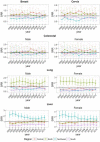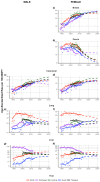National and Subnational Population-Based Incidence of Cancer in Thailand: Assessing Cancers with the Highest Burdens
- PMID: 28817104
- PMCID: PMC5575611
- DOI: 10.3390/cancers9080108
National and Subnational Population-Based Incidence of Cancer in Thailand: Assessing Cancers with the Highest Burdens
Abstract
In Thailand, five cancer types-breast, cervical, colorectal, liver and lung cancer-contribute to over half of the cancer burden. The magnitude of these cancers must be quantified over time to assess previous health policies and highlight future trajectories for targeted prevention efforts. We provide a comprehensive assessment of these five cancers nationally and subnationally, with trend analysis, projections, and number of cases expected for the year 2025 using cancer registry data. We found that breast (average annual percent change (AAPC): 3.1%) and colorectal cancer (female AAPC: 3.3%, male AAPC: 4.1%) are increasing while cervical cancer (AAPC: -4.4%) is decreasing nationwide. However, liver and lung cancers exhibit disproportionately higher burdens in the northeast and north regions, respectively. Lung cancer increased significantly in northeastern and southern women, despite low smoking rates. Liver cancers are expected to increase in the northern males and females. Liver cancer increased in the south, despite the absence of the liver fluke, a known factor, in this region. Our findings are presented in the context of health policy, population dynamics and serve to provide evidence for future prevention strategies. Our subnational estimates provide a basis for understanding variations in region-specific risk factor profiles that contribute to incidence trends over time.
Keywords: Thailand; health policy; incidence; projections; trends.
Conflict of interest statement
The authors declare that they have no conflict of interest.
Figures










References
-
- Ferlay J., Soerjomataram I., Ervik M., Dikshit R., Eser S., Mathers C., Rebelo M., Parkin D.M., Forman D., Bray F. Globocan 2012 Cancer Incidence and Mortality Worldwide. [(accessed on 26 January 2016)]; Available online: http://globocan.iarc.fr/
-
- Khuhaprema T., Attasara P., Sriplug H., Wiangnon S., Sangrajrang S. Cancer in Thailand Volume VII 2007–2009. National Cancer Institute, Ministry of Public Health; Bangkok, Thailand: 2013.
Grants and funding
LinkOut - more resources
Full Text Sources
Other Literature Sources

